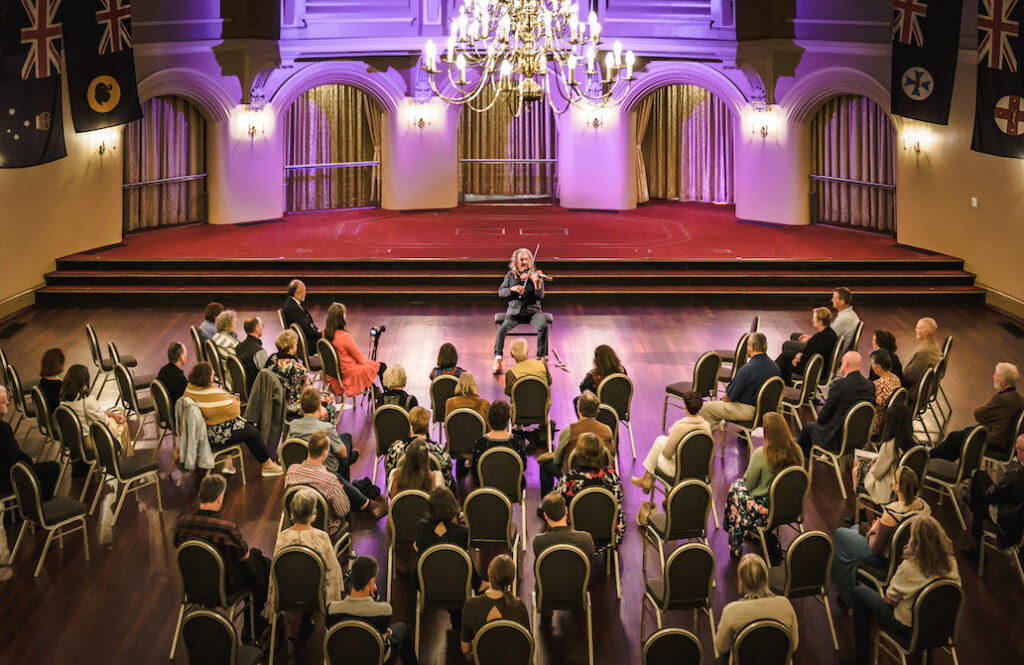Violinist and composer Rupert Guenther welcomes us into his inner world for a soul-searching evening of improvisation, writes Angela Ho.
Close encounter stirs the soul
18 September 2023
- Reading time • 5 minutesMusic
More like this
- Rewriting tradition with skill and charm
- The great unknown
- Master and apprentices leave you thirsty for more
New Letters to Esterhazy, Rupert Guenther
Government House Ballroom, 17 September 2023
There’s a single padded piano stool at the front of the Government House Ballroom, around which a semi-circle of seats has been arranged. The raised concert platform has been abandoned in favour of an intimate performance area about six metres in diameter.
It’s designed to be personal.
Around 40 or so people have decided to spend their Sunday afternoon with international violinist and composer Rupert Guenther, whose improvisatory classical style has attracted an eclectic range of admirers.
Given the intimacy of the occasion, I’ve abandoned my designated front-row seat for an inconspicuous one near the middle, hoping to be afforded the luxury of discreet observation.
“There’s no written program today,” Guenther tells us, assuming centre stage. “It’s all spoken.”
The concert’s titular work is a five-movement sonata, which he explains are his “musings and ramblings” as a 21st century Australian artist back in time to 18th-century Austrian composer Joseph Haydn.
Specifically, he’s hoping to speak to the 29 years during which the composer was employed with the Esterhazy court, whose beneficent patron enabled Haydn’s prolific output and musical exploration.
Guenther tells us he’ll be keeping an eye on his watch, so he’ll know when to stop. “I’ve played two-hour concerts before,” he laughs. “I won’t inflict that on you.”
The opening notes of New Letters to Esterhazy sonata are plaintive and keening. There’s a subtly gritty quality to Guenther’s sound owing to an intense engagement with the string, so that a constant forlorn drone colours the melodic material as it meanders across the top.

His lower register sings when he relies on it (which isn’t often for the first two movements), and his vibrato is tight but intentional. The ballroom is a responsive acoustic chamber, playing back every resonance with equal parts precision and drama.
The third movement marks a transition from pensiveness to relative urgency. In the discordant harmonies of the chordal opening, I imagine something like anger lacing Guenther’s letter — perhaps the Haydnesque Storm und Drang (storm and stress) — and wonder what provoked that intensity.
At this point, it dawns on me that my notes are all very technical. And to critique technique in the face of evocative improvisation is perhaps to miss the point.
I wonder whether there’s an inwardness about Guenther’s improvisatory concept. While it’s an ambitious task to share one’s inner world, he appears to have garnered a like-minded audience. They are the introspective, meditative kind: heads bowed, eyes closed, contemplating.
The penultimate movement assumes a redemptive, chorale-like character, before the fifth closes the sonata in something of an intrigue.
The second half of the concert features three smaller compositions: two inspired by experiences in Japan and Kashmir as a young man, and a third drawing from a collaboration with Indigenous elder Amos Roach in contemplation of the vast Kimberley region.
Guenther introduces each with a story, and Hakone Maple does indeed contain the whispery contours of shakuhachi flute, conveyed through tell-tale bow lifts and elegant phrase endings. And in the Arabic-inspired So Many Stars, the wail of microtonal trills do indeed suggest 4am Islamic prayers.
One suspects that beneath Guenther’s improvisation is a great deal of deep, considered deliberation. Because you cannot capture the essence of an idea without having first done the work of understanding its granularity. And he has clearly done the work.
The outcome is authenticity, gifted to a small crowd of personal interlocutors with whom he can share his sonic portraits.
I leave with more questions than answers. And for a concert of this kind, that is exactly what you want.
Pictured top: Rupert Guenther shows the power of improvisation at Government House Ballroom. Photo: Fiona Birt
Like what you're reading? Support Seesaw.





